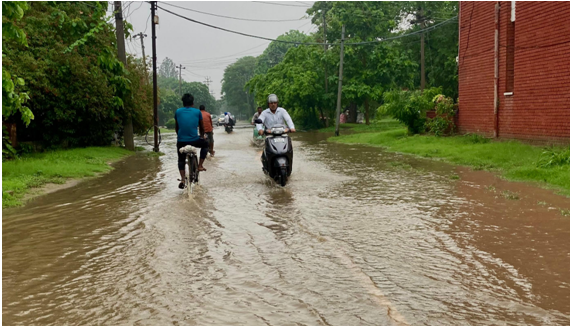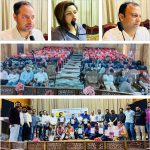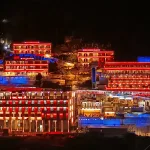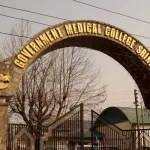In recent years, we have been witnessing erratic and unforeseen weather activities. Intense, short-duration downpours are responsible for triggering frequent urban flash floods. The situation has further worsened due to rapid urbanization where rainfall is unable to find a way to reach the soil matrix. The lack of permeable ground surfaces, paved roads and streets cause the rainwater to accumulate and lead to frequent urban flash floods. The problem has exacerbated since urban runoff carries sediments and floating garbage, which clogs the storm water conveyance network.
The Government of India in 2015 started National Smart Cities Mission with the ambitious goal of transforming cities across the country into more citizen-friendly and sustainable environments. Srinagar city is also being developed on the lines of smart city project. The smart city project aims to improve the living standards by various innovative and inclusive solutions. However, the ground reality is that these projects have largely neglected the crucial aspect of sustainable urban development. Instead, many of these “smart cities” are rapidly evolving into concrete jungles, where mere road paving and sewer installation fail to meet the comprehensive criteria of a truly smart and sustainable city. A smart city should embody sustainability, eco-friendliness and a harmonious integration with nature. Addressing the challenges posed by rapid urbanization is critical to mitigating the occurrence of urban floods.
Green infrastructure offers a sustainable, long-term, economical, aesthetically pleasing and environmentally friendly solution to urban floods. It mimics the natural hydrology of an area, captures rainwater where it falls and recharges it into groundwater. The concept of green infrastructure holds the potential to enhance urban sustainability, providing long-term flood prevention, rainwater filtration, and groundwater recharge. Green infrastructure techniques include green roofs, bioretention cells, permeable pavements, bioswales, planter boxes, green streets and alleys, etc. each of which can serve a specific purpose in urban rainwater management and beautification.
Green roofs
Green roofs are a modification of traditional roofs which consists of placing a waterproof membrane over layered by growing media where vegetation is grown. These roofs absorb the rainwater, a part of which is used by plants and returned to the atmosphere via evapotranspiration. They can retain up to 70-90% of the rainfall that falls on them, significantly reducing storm water runoff and thus reducing the strain on sewer systems during peak flow periods. Green roofs mitigate the urban heat island effect by providing a natural green cover in urban areas, thereby moderating the temperature of the buildings. Beyond these benefits, green roofs have been attributed to result in improved air quality, noise reduction, enhanced biodiversity and overall better health and wellbeing.
Bioretention cells
Bioretention cells are the artificial imitation of an ideal natural soil system with comparatively higher hydraulic conductivity and significant water quality improvement potential designed for managing urban storm water. They are the most widely adopted green infrastructure practices for managing urban storm water. A typical bioretention cell can infiltrate as much as between 85 to 90% of the annual storm water runoff, replenishing our groundwater resources. They have been found to be very effective in attenuation of peak rates of storm water runoff generated by rainfall events of varying intensities. In addition to reducing runoff, bioretention cells are highly effective in mitigating pollution and enhancing groundwater recharge. Bioretention cells can also be constructed economically using the locally available material and growing native plant species. The cost of construction varies between Rs. 125 to 250 per square foot to 335 to 500 per square foot (Albert Jarrett, 2022).
Permeable pavements
Conventional pavements consist of hard concrete surfaces that prevent water infiltration, leading to the accumulation of storm water and resulting in flash floods. Permeable pavements, on the other hand, are designed to treat, infiltrate, and replenish groundwater. Permeable pavements include porous asphalt, pervious concrete and permeable interlocking concrete pavers. Permeable pavements aim to restore the hydrological balance of urban paved areas by capturing rainwater and allowing it to slowly infiltrate the ground instead of flowing into storm water drains. The cost of installation may vary between Rs. 170- 335 per square feet depending upon the type of permeable pavements installed (Minnesota Stormwater Manual).
Bioswales
Bioswales are linear shallow landscaped depressions designed for the collection, filtration, infiltration and conveyance of storm water. The working principle is the same as that of bioretention cells, however unlike bioretention cells which are excavated depression, bioswales are vegetated channels that treat and infiltrate stormwater while conveying the same. Bioswales are best suited for highways and residential road runoff due to their linear nature. They are aesthetically pleasing than the traditional concrete gutters and use native plants and soil mix to absorb and filter stormwater.
Green Streets and Alleys
Green streets and alleys represent an excellent and innovative concept of integrating all green infrastructure practices in the urban infrastructure design process. Bioretention cells, bioswales, permeable pavements and trees can be used together to provide different environmental benefits in an urban ecosystem. The greenery and effective drainage in addition to growing biodiversity provide an excellent space for the local community to walk, play and interact. They turn uninviting alleys and streets into inviting and aesthetically pleasing public spaces bustling with various recreational activities.
Prioritizing green infrastructure not only enhances environmental sustainability but also improves the quality of life in urban areas. By integrating these practices, cities can mitigate environmental impacts and create vibrant, resilient communities that thrive amidst urbanization. It is a need of hour to embrace the concept to create a favorable urban living space for our future generations.
(Author is working as Assistant Professor at PG Department of Agriculture, Khalsa College Amritsar, Punjab. Feedback: [email protected])








